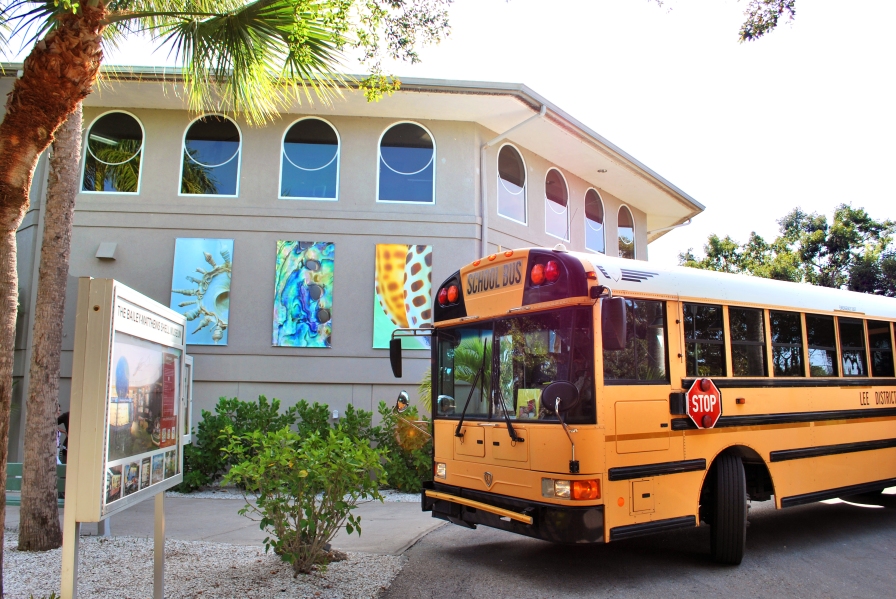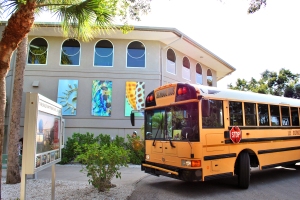Shell Museum seeking Adopt A Class donors
Published in Sanibel-Captiva Islander Sept. 2, 2015 issue
More than 35,000 fourth grade students from the Lee County School District have had an opportunity to visit the Bailey-Matthews National Shell Museum since 2003 when Ginny Avery began the Adopt A Class program.
Although the program serves schools throughout Lee County, it mainly touches low income families and those who are on free and reduced lunches. For many of the students, a trip to the museum is the first time they cross the bridge to visit Sanibel.
Last year, Bailey-Matthews National Shell Museum Assistant Director Melanie Moraga, who runs the program, said she took into consideration how far and how long it takes the schools to arrive at the museum. She said she gave schools in such places as Lehigh options to visit anytime besides February and March when the traffic is more congested. During those months she provided the option for The Sanibel School and Heights Elementary School with the opportunity to participate in the program.
“I love this part of my job. This is what fuels me. I love kids,” Moraga said.
Every year the museum sends out an annual Ask Letter requesting donations to help sponsor the Adopt A Class program. This year, the letter will be sent out after Labor Day.
“We send this to past donors, all members of the museum and for the second year, island residents on Sanibel and Captiva,” Moraga said.
For $350 an individual or business can Adopt A Class. The contribution pays for the entire field trip, so there is no cost to the student or the school. Last year roughly 60 donors provided funds for the program.
“I want to be able to get every kid in Lee County a visit in their elementary years, again in their high school years, or middle school. I would love for all of them to come here twice. That is my ultimate goal,” she said. “It’s an amazing program and I hope we can reach out and master getting every kid from Lee County here. I would love to go to Collier, Charlotte and then be able to do outreach programs via Skype.”
This year the Adopt A Class will feature a new component that allows the donors to tag along with their class when they visit the museum.
Development Associate Paul Gulbrandsen said the walk along is being included because they want to get the donors more involved by showing them exactly what their gift is doing for the kids.
“That is really what it’s all about,” he said. “To give the donors the option to go along with their class. They can see these kids and talk to these kids.”
From October through May, with this year going through June, fourth grade students arrive at the museum at 10:30 a.m. and stay until 12:30 p.m. for their field trip. Before arriving on their scheduled day, the teacher and students watch a movie supplied by the Shell Museum, so the children have a better understanding of where they are going.
“Last year was the first year we tested it and it worked,” Moraga said. “Instead of getting here and watching a movie, they already watched the movie. We ask that they watch it either the morning of, or the week before, so that their minds are fresh.”
Once they arrive, the students are gathered on the steps leading up to the shell museum for a group photograph. The students are then divided into groups before exploring the museum.
The students visit the live tank where they are educated about live mollusks and have the opportunity to touch and handle them with a marine biologist. The students also visit anywhere from 10 to 15 exhibits depending on the curriculum they are learning at school. From there they participate in Hands-on Science where they handle large shells that are no longer alive.
“They learn about the parts of the shell and feel inside the shell and see the babies and egg casings,” Moraga said about the scientific makeup of the shell after the mollusks dies.
A favorite of the field trip is the art project.
“They loved the art,” Moraga said of the kids painting a shell. “They thought this is the coolest thing in the world, that they were able to express their creativity and bring home something to mom, so they can have something to talk about over dinner.”
Once the project is completed the kids either eat outside under the new umbrellas or inside the museum.
The program not only touches the museum’s staff, but the teachers and students as well. Moraga shared a letter she received from one of the teachers last year.
“Today you are my hero. Because of your generosity my fourth grade students were treated to a day at the Bailey-Matthews National Shell Museum. From the moment we arrived excitement and awe was evident on everyone’s face and the question they asked were igneous.”
A special part of the program is putting together a package for the donors. The packet includes a letter from Moraga, a picture of the class, thank you letters from the kiddos and pictures of the shell magnets the fourth graders made.
“The program is awesome because you get to see the kid’s reaction and excitement and wanting to learn because it’s fun,” she said. “They all kept saying this is so much fun. This is cool. When you come to a museum that is not what you normally have in mind.”
For those interested in becoming an Adopt A Class donor can email fieldtrips@shellmuseum.org.
“We accept donations for the program all year long,” Moraga said. “If the donation comes in after May, I apply it for the upcoming school year.”

